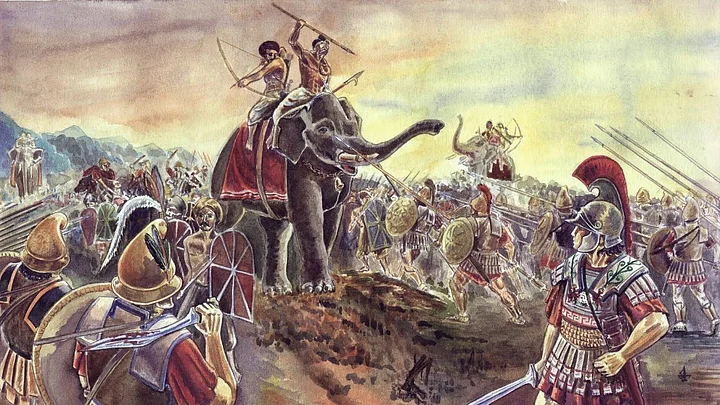Hindu-Muslim Conflict in India: Revisiting the Pre-Colonial Legacy
History Indian HistoryPosted by NewAdmin on 2025-02-11 08:45:40 |
Share: Facebook | Twitter | Whatsapp | Linkedin Visits: 11

Aurangzeb's Reinstatement of the Jizyah Tax
In 1679, the Mughal emperor Aurangzeb made the controversial decision to reinstate the jizyah tax, a levy on non-Muslims. This decision was rooted in his desire to enforce Islamic law across the empire and challenge what he perceived as non-Islamic practices. Saqi Mustad Khan, a historian and official in Aurangzeb’s court, explained that the emperor’s motivations were aligned with religious and canonical traditions, aiming to spread Islamic teachings and reduce the influence of infidel practices throughout the empire.
Shivaji Bhonsle's Opposition
The reinstatement of the jizyah tax did not go unnoticed, especially by Shivaji Bhonsle, the Hindu chieftain and leader of the Maratha resistance. Shivaji, who had founded the Maratha Empire in 1674 after rebelling against Mughal domination, condemned Aurangzeb's decision. To him, the tax represented an unjust religious imposition on the Hindu population and an infringement on their autonomy. His criticism of Aurangzeb’s policies highlighted the deepening sectarian divides between the Mughal rulers and regional powers like the Marathas.
Shivaji’s Wider Rebellion Against Mughal Rule
Shivaji’s objection to the jizyah tax was part of a broader resistance to Mughal authority. After declaring his independence from the Mughals, Shivaji’s Maratha Empire became a symbol of defiance. His opposition to the jizyah was not just a political stance but a fight for religious freedom and regional sovereignty against the centralized power of the Mughal Empire. His leadership in challenging Mughal religious and political policies helped solidify the Maratha Empire’s growing influence in India.
Legacy of Sectarian Tensions
The conflict over the jizyah tax exemplifies the ongoing Hindu-Muslim tensions in Indian history. The tax, and the resistance it sparked, played a pivotal role in shaping the dynamics of religious and political power in India during the 17th century. The sectarian divide that emerged during this period, epitomized by figures like Aurangzeb and Shivaji, laid the foundation for future conflicts that would continue to influence the social and political landscape of the subcontinent.
Search
Categories
- Sports
- Business
- History
- Politics
- International
- Science & Technology
- Social Issues
- Disaster Management
- Current Affairs
- Education
- Startup Business
- Startup News
- Awards
- Community Services
- Fundraising Events
- Volunteer Services
- Health Initiatives
- Innovations and Initiatives
- In News
- dummybanners
- Awards
- Partners
- Products
- Press Releases
- News
- Fast Check
- South
- సినిమా
- Gallery
- Sunday Chronicle
- Hyderabad Chronicle
- లైఫ్ స్టైల్
- National
- క్రైం
- ట్రెండింగ్
- జాబ్స్
- అంతర్జాతీయo
- బిజినెస్
- రాజకీయం
- బిజినెస్
- సంపాదకీయం
- నవ్య
- చిత్ర జ్యోతి
- క్రీడలు
- జాతీయం
- తెలంగాణ
- తాజా వార్తలు
- మన పార్టీ
- మన నాయకత్వం
- మన విజయాలు
- డౌన్లోడ్స్
- మీడియా వనరులు
- కార్యకర్తలు
- North East Skill Center News
- Government Schemes
- Entrepreneurship Support
- Employment Opportunities
- Skill Training Programs
- Departments
- Investments
- Initiatives
- Resources
- Telangana IT Parks
- Events & Jobs
- Press Releases
- News
- Airport News
- Newtons Laws of Motion
- Karbonn in Business
- Investments in Karbonn
- Company quarterly sales
- Markets
- Auto News
- Industry
- Money
- Advertisements
- Stock target
- Company Updates
- Stock Market
- Company Sales
- Staffing and HR
- Constituency Assembly
- General News
- Srikalahasti Temple
- Bojjala Sudhir Reddy
- Technology & Innovation
- Sports
- Business
- Products
- Industries
- Services & Trainings
- Tools & Resources
- Technology Integration
- Drug Seizures & Arrests
- Telangana Narcotics
- Law & Enforcement
- Rehabilitation
- Nationwide Drug Policing
- Nigeria Seizures
- Global Operations
- Drug Awareness
- Drug Enforcement Tech
- NCB Drug Seizures
- Judicial Crackdown
- India's Surveillance Tools
- Cross-Border Links
- Women Safety
- Cyber Crimes
- Drug Abuse
- Traffic & Road Safety
- Community Connect
- Public Safety Alerts
- Citizen Assistance
Recent News
- 'Replace Karun Nair With....': India's Future Test Hope Recommended
- Vaibhav Suryavanshi Enters Record Books As India-England U-19 Test Breaks 1497-Run Mark
- Man who killed 5 family members has death sentence reduced to life without remission
- Kannada Actor Ranya Rao, Arrested For Gold Smuggling, Sent To Jail; No Bail Allowed
- State violence unfolds as locals resist eviction from Assam's breathtaking Gibbon Forest
- 'Best Interest': SC Reverses Order On Child Custody After He Develops Stress In Mother's Absence
- Can Trump Fire Fed Chair Jerome Powell? Here's What Law Says, And Why It May Not Be Easy
- The Income Tax Notice You Received: What to Do Next